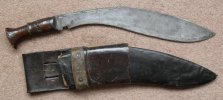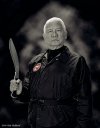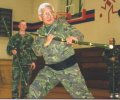What I am going to say is not from personal experience because I don't live in Nepal or a developing world so input from someone who does/has can help us here...
But it is my guess that the person you see in Nepal (or another less wealthy country) using just a Kukri or only one tool is most likely too poor to own any other tool and need an all round instrument. He/She can not afford to
add a sickle, a saw, a billhook, an axe, a weed whacker, a chain saw, etc. to their household. Specialization is for the developed nations or individual that can afford it. Soapbox ended.
View attachment 307581
So for us folks with the money the Kukri is for collecting, for fun, and/or for use. Focusing on use the Kukri is a very important multifunctional camp/hiking tool that saves on weight.
View attachment 307582
For your stated purpose above Kookery the Kukri would work well in light to medium duty applications. I am a fanboy for the Kukri but don't limit yourself either. Their are many great blade designs albeit the Khukuri is the most famous. Good luck and stay safe.









